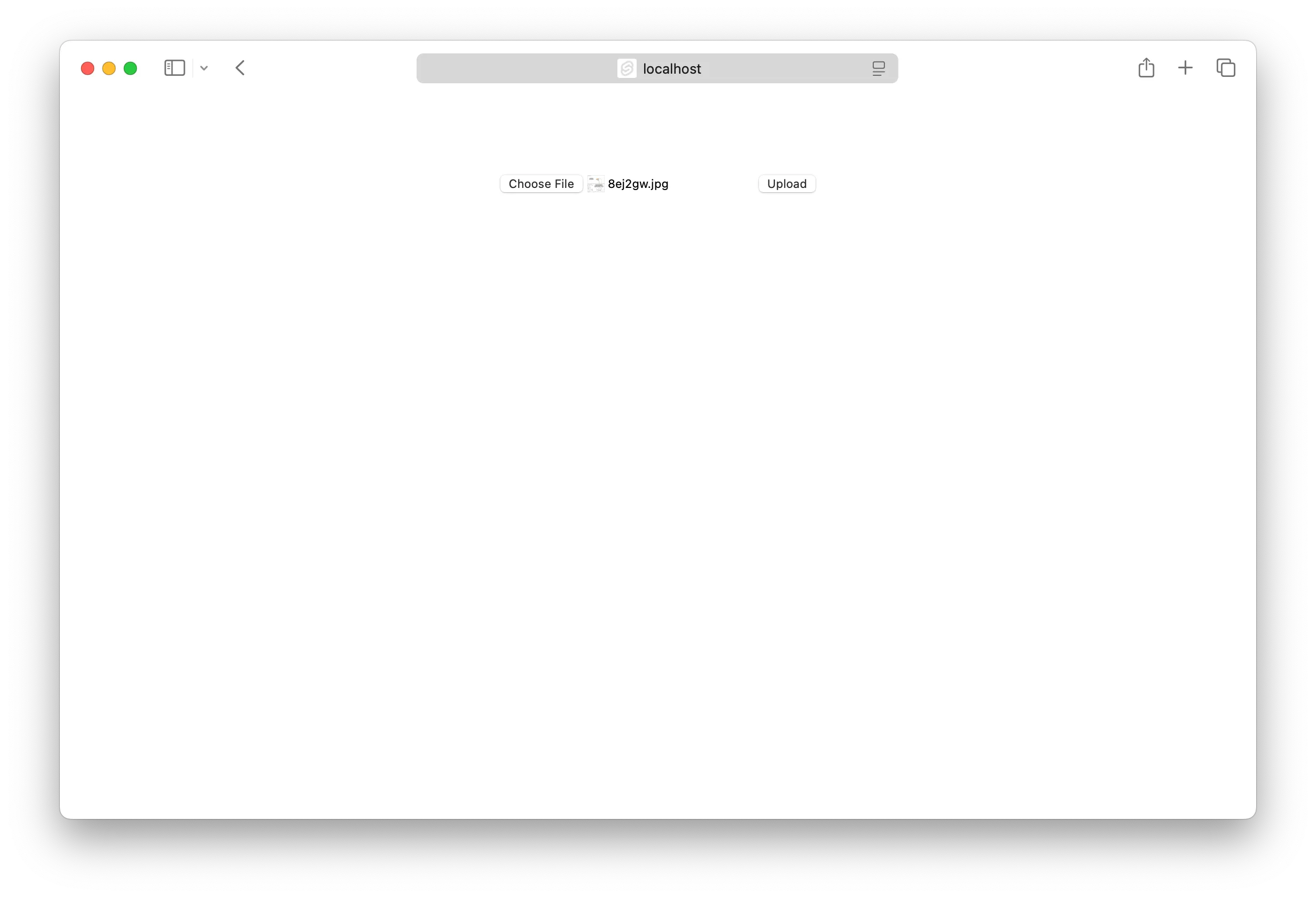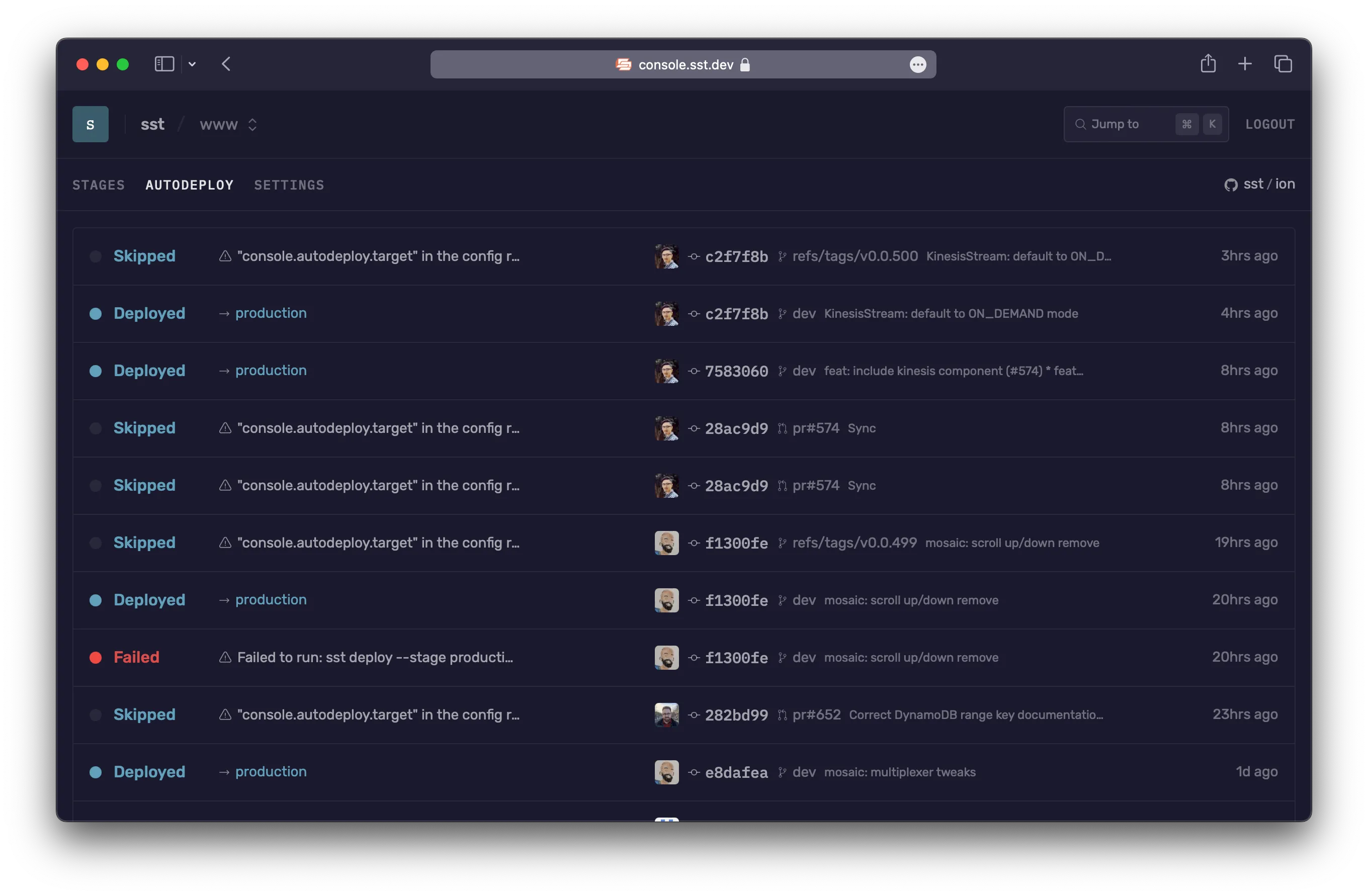SvelteKit on AWS with SST
There are two ways to deploy a SvelteKit app to AWS with SST.
We’ll use both to build a couple of simple apps below.
Examples
We also have a few other SvelteKit examples that you can refer to.
Serverless
We are going to create a SvelteKit app, add an S3 Bucket for file uploads, and deploy it using the SvelteKit component.
Before you get started, make sure to configure your AWS credentials.
1. Create a project
Let’s start by creating our app.
npx sv create aws-svelte-kitcd aws-svelte-kitWe are picking the SvelteKit minimal and Yes, using TypeScript syntax options.
Init SST
Now let’s initialize SST in our app.
npx sst@latest initnpm installSelect the defaults and pick AWS. This’ll create a sst.config.ts file in your project root.
It’ll also ask you to update your svelte.config.mjs with something like this.
import adapter from '@sveltejs/adapter-auto';import adapter from "svelte-kit-sst";Start dev mode
Run the following to start dev mode. This’ll start SST and your SvelteKit app.
npx sst devOnce complete, click on MyWeb in the sidebar and open your SvelteKit app in your browser.
2. Add an S3 Bucket
Let’s allow public access to our S3 Bucket for file uploads. Update your sst.config.ts.
const bucket = new sst.aws.Bucket("MyBucket", { access: "public"});Add this above the SvelteKit component.
Link the bucket
Now, link the bucket to our SvelteKit app.
new sst.aws.SvelteKit("MyWeb", { link: [bucket]});3. Create an upload form
Let’s add a file upload form. Replace your src/routes/+page.svelte. This will upload a file to a given pre-signed upload URL.
<script> /** @type {import('./$types').PageData} */ export let data;
const handleSubmit = async (e) => { const formData = new FormData(e.target); const file = formData.get("file");
const image = await fetch(data.url, { body: file, method: "PUT", headers: { "Content-Type": file.type, "Content-Disposition": `attachment; filename="${file.name}"`, }, });
window.location.href = image.url.split("?")[0]; };</script>
<section> <form on:submit|preventDefault={handleSubmit}> <input name="file" type="file" accept="image/png, image/jpeg" /> <button type="submit">Upload</button> </form></section>Add some styles.
<style> section { flex: 0.6; display: flex; padding-top: 4rem; align-items: center; flex-direction: column; justify-content: center; }</style>4. Generate a pre-signed URL
When our route loads, we’ll generate a pre-signed URL for S3 and our form will upload to it. Create a new src/routes/+page.server.ts and add the following.
/** @type {import('./$types').PageServerLoad} */export async function load() { const command = new PutObjectCommand({ Key: crypto.randomUUID(), Bucket: Resource.MyBucket.name, }); const url = await getSignedUrl(new S3Client({}), command);
return { url };}Add the relevant imports.
import { Resource } from "sst";import { getSignedUrl } from "@aws-sdk/s3-request-presigner";import { S3Client, PutObjectCommand } from "@aws-sdk/client-s3";And install the npm packages.
npm install @aws-sdk/client-s3 @aws-sdk/s3-request-presignerHead over to the local SvelteKit app in your browser, http://localhost:5173 and try uploading an image. You should see it upload and then download the image.

5. Deploy your app
Now let’s deploy your app to AWS.
npx sst deploy --stage productionYou can use any stage name here but it’s good to create a new stage for production.
Congrats! Your app should now be live!
Containers
We are going to create a SvelteKit app, add an S3 Bucket for file uploads, and deploy it in a container with the Cluster component.
Before you get started, make sure to configure your AWS credentials.
1. Create a project
Let’s start by creating our project.
npx sv create aws-svelte-containercd aws-svelte-containerWe are picking the SvelteKit minimal and Yes, using TypeScript syntax options.
Init SST
Now let’s initialize SST in our app.
npx sst@latest initnpm installSelect the defaults and pick AWS. This’ll create a sst.config.ts file in your project root.
It’ll also ask you to update your svelte.config.mjs. But we’ll instead use the Node.js adapter since we’re deploying it through a container.
npm i -D @sveltejs/adapter-nodeAnd updating your svelte.config.js.
import adapter from '@sveltejs/adapter-auto';import adapter from '@sveltejs/adapter-node';2. Add a Service
To deploy our SvelteKit app in a container, we’ll use AWS Fargate with Amazon ECS. Replace the run function in your sst.config.ts.
async run() { const vpc = new sst.aws.Vpc("MyVpc"); const cluster = new sst.aws.Cluster("MyCluster", { vpc });
new sst.aws.Service("MyService", { cluster, loadBalancer: { ports: [{ listen: "80/http", forward: "3000/http" }], }, dev: { command: "npm run dev", }, });}This creates a VPC, and an ECS Cluster with a Fargate service in it.
The dev.command tells SST to instead run our SvelteKit app locally in dev mode.
Start dev mode
Run the following to start dev mode. This’ll start SST and your SvelteKit app.
npx sst devOnce complete, click on MyService in the sidebar and open your SvelteKit app in your browser.
3. Add an S3 Bucket
Let’s allow public access to our S3 Bucket for file uploads. Update your sst.config.ts.
const bucket = new sst.aws.Bucket("MyBucket", { access: "public"});Add this below the Vpc component.
Link the bucket
Now, link the bucket to the container.
new sst.aws.Service("MyService", { // ... link: [bucket],});This will allow us to reference the bucket in our SvelteKit app.
4. Create an upload form
Let’s add a file upload form. Replace your src/routes/+page.svelte. This will upload a file to a given pre-signed upload URL.
<script> /** @type {import('./$types').PageData} */ export let data;
const handleSubmit = async (e) => { const formData = new FormData(e.target); const file = formData.get("file");
const image = await fetch(data.url, { body: file, method: "PUT", headers: { "Content-Type": file.type, "Content-Disposition": `attachment; filename="${file.name}"`, }, });
window.location.href = image.url.split("?")[0]; };</script>
<section> <form on:submit|preventDefault={handleSubmit}> <input name="file" type="file" accept="image/png, image/jpeg" /> <button type="submit">Upload</button> </form></section>Add some styles.
<style> section { flex: 0.6; display: flex; padding-top: 4rem; align-items: center; flex-direction: column; justify-content: center; }</style>5. Generate a pre-signed URL
When our route loads, we’ll generate a pre-signed URL for S3 and our form will upload to it. Create a new src/routes/+page.server.ts and add the following.
/** @type {import('./$types').PageServerLoad} */export async function load() { const command = new PutObjectCommand({ Key: crypto.randomUUID(), Bucket: Resource.MyBucket.name, }); const url = await getSignedUrl(new S3Client({}), command);
return { url };}Add the relevant imports.
import { Resource } from "sst";import { getSignedUrl } from "@aws-sdk/s3-request-presigner";import { S3Client, PutObjectCommand } from "@aws-sdk/client-s3";And install the npm packages.
npm install @aws-sdk/client-s3 @aws-sdk/s3-request-presignerHead over to the local SvelteKit app in your browser, http://localhost:5173 and try uploading an image. You should see it upload and then download the image.

6. Deploy your app
To deploy our app we’ll add a Dockerfile.
FROM node:18.18.0-alpine AS builder
WORKDIR /appCOPY package*.json .RUN npm installCOPY . .RUN npm run buildRUN npm prune --prod
FROM builder AS deployer
WORKDIR /appCOPY --from=builder /app/build build/COPY --from=builder /app/package.json .EXPOSE 3000ENV NODE_ENV=productionCMD [ "node", "build" ]This builds our SvelteKit app in a Docker image.
Let’s also add a .dockerignore file in the root.
.DS_Storenode_modulesNow to build our Docker image and deploy we run:
npx sst deploy --stage productionYou can use any stage name here but it’s good to create a new stage for production.
Congrats! Your app should now be live!
Connect the console
As a next step, you can setup the SST Console to git push to deploy your app and view logs from it.

You can create a free account and connect it to your AWS account.